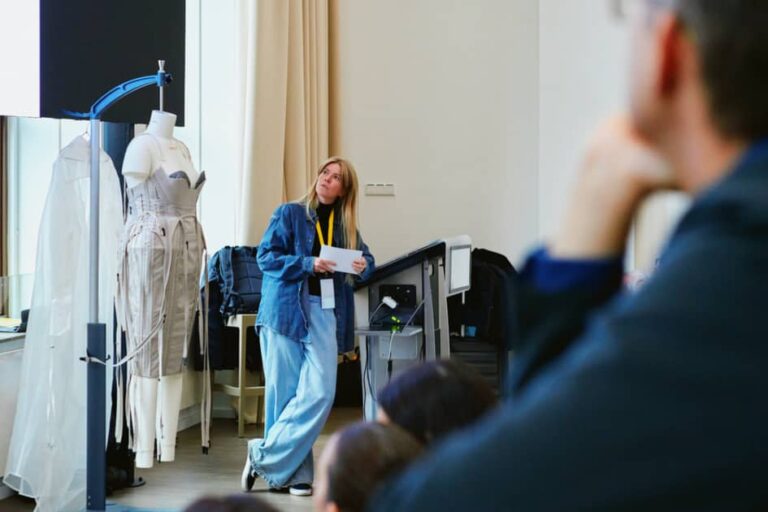On November 21 and 22, more than 150 fashion professionals and students gathered at the Amsterdam Fashion Institute to share and gather insights on developments in the field of 3D technology and design. The two-day event, 3D NXT LEVEL 3.0, co-organized by the IAF and sponsored by Alvanon and the Hochschule Albstadt-Sigmaringen, aimed to provide insight into the product and process innovations in the field of digital product creation (DPC), from sourcing to sales .
FashionUnited had the opportunity to attend the second day of the event and learn more about developments in the world of 3D fashion.
AMFI and the fashion of the future 2040
The way forward for implementing and optimizing 3D technology in fashion depends heavily on collaboration, but also on education. This idea was strongly emphasized in all lectures at the well-attended event. The kick-off of day two was given by Prof. Dr. ir. Troy Nachtigall from AMFI and TU Eindhoven, with a vision of The 2040 Fashion of the Future, which served as a reminder of where the industry’s 3D and technological developments are heading. Furthermore, how can they help meet EPR (Extended Producer Responsibility) goals and legislation?
Nachtigall highlighted that this is the most important time for the sector since the 1980s and underlined the transformation needed in the fashion industry to meet European climate neutrality targets by 2030, and achieve full circularity by 2040. Digital design and fashion workflow tools such as Clo and Alvanon become essential for sustainability and efficiency through real-time sampling, while AI and machine learning simplify complex systems such as textiles, fit and adaptive designs. AMFI shared with the audience that in the new curriculum, design students start by learning digital software and physical pattern cutting at the same time.
Nachtigall further raised an interesting point, comparing dust to data. At AMFI they treat data as a material – a clay that can be molded to shape textures, experiences and even entire garments. By viewing data in this way, industry professionals can unlock new possibilities in design, changing the way they create and innovate across the fashion chain.
Adaptable content at scale: INDG’s partnership with Speedo
The company INDG showed how digital innovation is changing the industry at the sample and asset level, through their work with CGI, automated content generation and digital twin generation. In a Q&A panel format, they discussed their partnership with Speedo and demonstrated the benefits of moving away from traditional workflows and embracing 3D content creation. Using automation pipelines, INDG helped Speedo produce more than 16,000 photorealistic renders in a single season, accelerating timelines and eliminating the need for physical samples.
INDG recognized the possibilities of integrating 3D technology into an industry rooted in traditional methods. Convincing stakeholders to embrace digital workflows and move beyond the “no sample, no sale” mentality remains a challenge. However, their work with Speedo shows that 3D can not only improve efficiency, but also align with sustainability goals by reducing physical waste. INDG also emphasized the importance of involving all stakeholders in the use of 3D technology: “Involving all stakeholders – design, development, sales and merchandising – is essential for a smooth transition to 3D workflows.”
Tess van Zalinge and The Fabricant
AMFI alumna and designer Tess van Zalinge highlighted the freedom that 3D technology offers, allowing prototyping and creative exploration without the limitations of traditional methods. Using 3D models from Alvanon, she was able to design couture clothing in size 14. She discovered that challenges such as adapting designs to avatars and tailoring physical fits demonstrate the importance of continuing to combine digital and physical processes. For Van Zalinge, 3D design is not only a tool, but also a way to reimagine couture for different sizes and target groups.
The Fabricant, a digital fashion house founded by an AMFI alumnus, presented a vision on the future of digital fashion during the event. Their mission – creating a more sustainable, equitable and creative fashion industry – has been the driving force behind their work since their founding in Amsterdam in 2018. The Fabricant shared projects such as their $10,000 digital clothing sale and collaborations with luxury brands like Maison Margiela and Caterpillar, highlighting the scalability and environmental benefits of digital fashion, where a single item can be reproduced infinitely without physical production.
The presentation focused on the integration of AI tools to democratize design. Their emerging platform Fabricant Intelligent Tools allows users to convert sketches into photorealistic 3D models, eliminating the need for physical prototypes. By automating complex processes such as pattern extraction and virtual trials, they aim to streamline the path from concept to marketing images and make participation in digital fashion more accessible.
Collaboration in implementing 3D processes
The day ended with closing remarks and lunch, leaving attendees inspired, but also with questions about translating large-scale 3D innovations into practical solutions for smaller companies. Reflecting on INDG’s talk and Bershka’s presentation on impressive in-house 3D operations the day before, many wondered how these could be applied on a smaller scale. The consensus, as highlighted in the closing remarks, was clear: effective implementation does not require flashy conferences or endless meetings. Instead, you should focus on identifying specific challenges, finding tailored solutions and engaging stakeholders across the company or beyond.
Smaller companies don’t need to match the scale of Bershka’s operations or Speedo’s 16,000 renders. The key is to tailor 3D technology to the unique requirements of your own company. According to Prof. Dr.-Ing. Christian Kaiser in the closing remarks, going forward, the industry must prioritize asking the right questions, breaking down challenges into tangible steps, and addressing specific problems with systemic solutions. This collaborative approach will be crucial in ensuring that 3D technology becomes an accessible and scalable tool across the fashion landscape.
Event photography: Willem de Kam, Instagram: @willemdekam_


